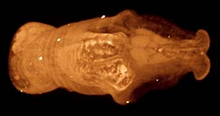Caudofoveata
| Caudofoveata | |
|---|---|

| |
| Anterior 1.4 mm of a fixed and stained specimen of Falcidens sp. | |
| Scientific classification | |
| Domain: | Eukaryota |
| Kingdom: | Animalia |
| Phylum: | Mollusca |
| Class: | Caudofoveata |
| Families and genera | |
Caudofoveata is a small class within the phylum Mollusca, also known as Chaetodermomorpha. The class is often combined with Solenogastres and termed Aplacophora, but some studies have cast doubt on the monophyly of this group.[1]
Anatomy
Caudofoveata are small (1–30 mm), mainly deep sea molluscs. They are worm-like, lacking shells or distinct muscular feet; they instead have scales and calcareous spines called sclerites, for movement.
Ecology
Caudofoveates live by burrowing through soft sediment, and feed by lying vertically in the sediment with just the mouthparts exposed and taking in passing organic detritus. During sexual reproduction, the female produces eggs which are fertilized and brooded, and then the larvae swim freely.
Diet
Caudofoveates feed on foramanifera.[2]
Taxonomy
Caudofoveata comprises the following families and genera:[citation needed]
There are 15 genera, with about 150 known species.
References
- ^ Giribet, G.; Okusu, A, A.; Lindgren, A.R., A. R.; Huff, S.W., S. W.; Schrödl, M, M.; Nishiguchi, M.K., M. K. (May 2006). "Evidence for a clade composed of molluscs with serially repeated structures: monoplacophorans are related to chitons". Proceedings of the National Academy of Sciences of the United States of America. 103 (20): 7723–7728. Bibcode:2006PNAS..103.7723G. doi:10.1073/pnas.0602578103. PMC 1472512. PMID 16675549.
- ^ Guralnick, R.; Smith, K. (1999). "Historical and biomechanical analysis of integration and dissociation in molluscan feeding, with special emphasis on the true limpets (Patellogastropoda: Gastropoda)". Journal of Morphology. 241 (2): 175–195. doi:10.1002/(SICI)1097-4687(199908)241:2<175::AID-JMOR7>3.0.CO;2-0. PMID 10420163.
